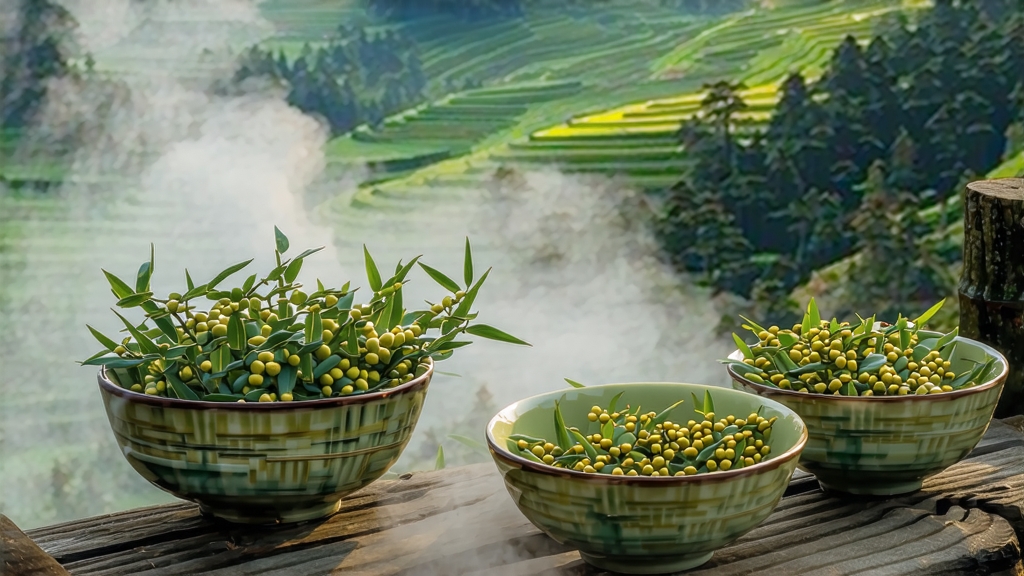
High above the Sichuan Basin, where the Min River carves through folds of limestone and bamboo forests exhale perpetual fog, lies the original cradle of yellow tea: Meng Ding Mountain. For twelve centuries the tiny village of Ya’an has sent springtime caravans of down-covered buds to imperial courts, Buddhist monasteries and, today, to the quiet gaiwans of tea lovers who seek the elusive flavor known simply as “menhuang”—the gentle yellowing that turns green into gold. Meng Ding Huang Ya, literally “Meng Summit Yellow Bud,” is the least industrialized, most temperamental member of China’s yellow tea family; it is also the most aromatic window onto a processing art that once teetered on the edge of extinction.
History: From Tang Tribute to Republican Refuge
The first written record appears in the Tang dynasty’s national tax register (816 CE), listing “Meng Mountain Sweet Bud” among the eight teas required to be steamed, pressed into cakes, and sent to Chang’an. When Song emperor Huizong—himself a skilled tea painter—decreed in 1107 that only yellow tea could be offered at the Altar of Heaven, Meng Ding’s shoots, naturally yellow-tinged from mountain mists, became the archetype. Caravans crossed the perilous Luding suspension bridges, entering Tibet as part of the “tea-for-horse” exchange; the same leaves that pacified border warlords also inspired poets to compare their liquor to “the first ray of dawn caught in liquid jade.” After the 1911 revolution, imperial demand collapsed and yellowing kilns cooled for decades. It was not until 1958, when a retired Song-era processing manuscript was discovered inside a monastery’s Tripitaka cabinet, that state tea engineers revived the technique, establishing the micro-region of Shangqing, Zhongqing and Xiaqing peaks as the protected origin.
Micro-Terroir: Why Mist Matters
Meng Ding enjoys a unique three-climate stack: subtropical valley heat below, perennial cloud cover at 1,400 m, and alpine wind above 1,600 m. Diurnal swings of 15 °C slow amino-acid metabolism, concentrating L-theanine; meanwhile, 85 % relative humidity encourages a natural down—fine white hairs—on every apical bud. The soil is a crumbly slate-loam, slightly acidic (pH 4.9) and laced with selenium leached from ancient marine fossils. Growers insist that the mountain’s morning “rain fog” (yu wu) carries indigenous yeasts that seed the yellowing phase; laboratory assays confirm a higher population of Wallemia sebi on leaf surfaces here than in any other Chinese tea region, a possible microbial ally in creating the tea’s signature “stuffed rice” aroma.
Plants and Picking Standards
Only the local cultivar “Meng Ding Xiao Ye Zhong” (small-leaf heirloom) is legally permitted. Its dormant winter buds accumulate soluble sugars, so spring plucking begins with the lunar term “Insects Awaken” (early March) and ends before “Grain Rain,” a window of barely twenty days. Pickers climb 45-degree slopes at dawn while leaves are still turgid with overnight dew, selecting only the unopened “sparrow-tongue” set: one bud sheathed by two opposing leaves no longer than 2.5 cm. A master can finish 1 kg of fresh leaf by noon; 5 kg are required for 1 kg of finished tea, translating into roughly 18,000 plucks.
Crafting the Yellow: Five Steps Between Green and Gold
Yellow tea’s identity rests on a single, nerve-wracking phase—men huang (“sealed yellowing”)—that borrows green tea’s kill-green step yet refuses its immediacy, allowing non-enzymatic oxidation to tint leaf and liquor alike. Meng Ding Huang Ya undergoes five sequential stages:
-
Sha Qing (Kill-Green) – 200 °C bamboo-roasted woks, 4 minutes
Leaves are tossed by hand until rustling like silkworms eating mulberry; moisture drops to 55 %, polyphenol oxidase is denatured, yet interior cells remain alive. -
Re-Nie (Hot-Rubbing) – 70 °C, linen cloth bundles
Immediately after wok work, scalding leaves are rolled inside cloth cylinders, twisting cell